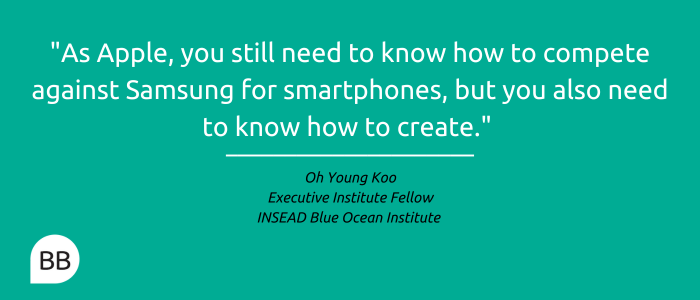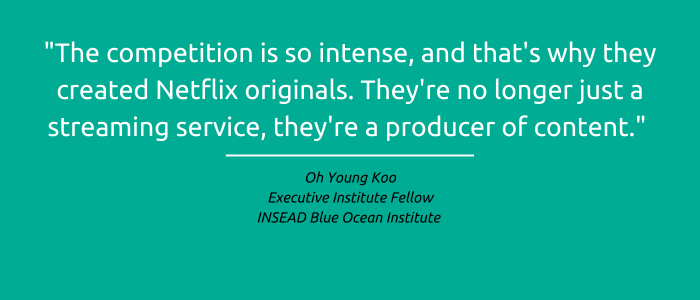The term blue ocean strategy was coined in 2005 by INSEAD professors Chan Kim and Renée Mauborgne, in their co-authored book, Blue Ocean Strategy.
Even if you haven’t come across the term, or don’t know what it means, you’ll have likely come across a company that’s adopted a blue ocean strategy or a blue ocean shift.
Think of Netflix, Cirque du Soleil, and even classical music superstar Andre Rieu. If you’ve come across any of these, you’ve come across blue ocean strategy.
What is blue ocean strategy?
According to Chan and Renée (pictured), blue ocean strategy is when a company simultaneously pursues differentiation and low cost to open a new market space and create new demand. A blue ocean is an unknown market space untainted by competition; it revolves around value innovation.
It’s essentially about ‘creating and capturing uncontested market space, thereby making the competition irrelevant.’ The blue ocean strategy encourages you to innovate and develop new, affordable products that make competition irrelevant.
Oh Young Koo, executive institute fellow at INSEAD’s Blue Ocean Strategy Institute, explains that blue ocean theory goes beyond what is traditionally taught as strategy in the core MBA syllabus.
“In business school, what you learn in the strategy 101 course is on how to compete with competitors and increase your market share,” she says. “You learn industry structure, how to analyze, compete head on, and grab more than your competitors.
“But a problem arises when competition becomes intense, because the profit margin shrinks, and you go into a price war against your competitors.”

A hotly contested market is what Chan and Renée call a red ocean. A red ocean can put the future of your business at risk if you fail to compete. Profits and growth can atrophy as companies try to outperform their rivals by grabbing a larger share of an existing market.
“What Chan and Renée did was less about how to compete, and more about how to create,” Oh Young (pictured) explains. “They came up with blue ocean strategy to provide tools and frameworks to the businesspeople, so they don't have to compete head on and can create a new market space where competition is obsolete to begin with.”
The introduction of blue ocean theory split strategy education into two camps: market competing strategy and market creating strategy.
A blue ocean though, Oh Young explains, is never a blue ocean for long. Once a company makes the first move into an uncontested market, competition will inevitably follow.

INSEAD's Blue Ocean Strategy Institute
How to implement a blue ocean shift
Moving into a blue ocean is a strategy that can be adopted by new startups looking to infiltrate untapped market potential, as well as already established multinationals looking to launch new business units in areas previously unexplored.
In their latest work, Chan and Renée outline how to implement a blue ocean shift—a roadmap for successfully moving from a red ocean into a blue ocean.
Moving into a blue ocean doesn’t mean leaving the red ocean behind though, warns Oh Young. “As Apple, you still need to know how to compete against Samsung for smartphones,” she says, “but you also need to know how to create.”
There are five steps to implementing a blue ocean shift:
→ Get Started. Choose the right place to start your blue ocean initiative
→ Understand where you are now. Get clear on the current state of play
→ Imagine where you could be. Uncover the hidden pain points imposed by your industry
→ Find out how to get there. Reconstruct market boundaries – systematically
→ Make your move. Select and rapidly test your blue ocean move. Formalize your big-picture business model and launch your move
“The company doesn't have to follow from step one to five,” Oh Young explains. “They can just pick the tools or the step that is relevant to them.
“It's very iterative, which means that you can go back and forth between the stages, between the steps, so that you can come up with a better idea.”
The process is not about getting to a right answer immediately, but more a journey to arrive at as many blue ocean alternatives as possible. And for that to be done successfully, having the right people is vital.
You need people who can take the initiative and lead the blue ocean project from start to finish, according to Oh Young, who says it’s imperative that companies have employees who can both formulate and execute the blue ocean strategy.

Blue Ocean Strategy examples
Cirque du Soleil
Entertainment company and contemporary circus, Cirque du Soleil, was launched in 1984 and its success over the last four decades is in part the result of a blue ocean strategy that’s kept any serious competitors at bay.
When it launched it challenged the longstanding conventions of the circus industry, with one major move being the decision to include no animals at all in its performances. It moved out of the red ocean of traditional circus and into a new market that appealed to an entirely different audience: adults and corporate clients.
André Rieu
André Rieu and his Johann Straus Orchestra challenged what it meant to attend a classical music concert at a time when demand was down, costs were up, and profits were shrinking.
“André Rieu leads an orchestra that combines classical music and pop music, so it’s a really different music concert experience,” Oh Young explains.
“He’s been running his orchestra for more than 30 years as well, but there’s no other competitors in his business.”
André Rieu’s blue ocean strategy tapped into new demand by looking at noncustomers of classical concerts and reconstructed the industry’s boundaries to create a new market space he’s dominated since.
citizenM
Whereas André Rieu and Cirque du Soleil carved out new markets, citizenM hotels adopted blue ocean theory to shift from the red market of the hotel industry to untapped market space that existed outside of traditional 5*, 4*, and 3* hotels.
Michael Levie and Rattan Chadha, the cofounders of citizenM, wanted to create a new kind of hotel chain, Oh Young explains, that felt like a 5* experience at a 3* price.
They considered the competing factors across hotels operating in the 3*, 4*, and 5* range that they could potentially do without. They cut out bell boys, door people, the concierge, the front desk, room service, and restaurants. Instead, they hired multitasking ambassadors who go from making barista-quality coffee to helping with check-in queries and housekeeping.
Oh Young explains that citizenM focused on what travelers are concerned about the most when they stay at a hotel—sleeping comfortably, the WiFi connection, and location, for example—and optimized those things. They also replaced the lobby with a space seen as a ‘big living room’, where guests can relax.
Netflix
Netflix is another famous example of a blue ocean strategy done well. When the firm shifted from a DVD rental company to a streaming service, it started a seismic shift in the way we consumed movies and television and became hugely successful as a result.
“They saw that the future was streaming,” Oh Young says. “At the time the mail service was doing very well but they decided to get rid of it and went right ahead with streaming.”
Over the last several years the emergence of other streaming services like Amazon Prime Video, Apple TV+, and Disney+ has pushed Netflix to adapt again. The company’s continued success is down to a series of sensible strategy moves.
“The competition is so intense, and that's why they created Netflix originals,” Oh Young explains. “They're no longer just a streaming service, they're a producer of content.”
Nintendo
Finally Nintendo is a good example of blue ocean strategy. When Nintendo introduced the Wii in 2006, the company avoided competing with the Xbox and Playstation on graphics.
Instead, Nintendo prioritized wireless motion-control gameplay that was unavailable on other systems. That’s how Nintendo was able to introduce more interactive, physical games like the Wii Sports series. The games’ popularity – as well as that of the console – grew rapidly.

Blue ocean strategy pitfalls to be aware of
There are several pitfalls to be aware of when implementing your blue ocean strategy:
1. Just because you’re the first mover, doesn’t mean your strategy will be successful
Just because you’ve come up with an innovative idea to move into untapped market space, that doesn’t mean you’re going to be successful.
Blue ocean strategy isn’t just about becoming a market pioneer, it’s about consolidating your position in a new market space, Oh Young says.
She points to the example of Google Glass. It failed to take off into a commercially viable product, but still acted as a market pioneer.
“The purpose of a company to apply blue ocean is to make a profitable business. But if it’s just a technological breakthrough that failed to create compelling buyer value, like Google Glass did, it is the value, with or without technology, that leads to a successful blue ocean strategy.”
2. You need a separate strategy for the red ocean that emerges after your blue ocean strategy move
When a blue ocean becomes red as competition comes along, a blue ocean strategist has three options.
The first is to build barriers to imitation, so you can enjoy your position in an untapped market for as long as possible. The second is to keep innovating and create a new blue ocean. And the third way is to fight against the competition, to defend your market share. A company should know how to compete as well as how to create.
3. You’re nothing without the employees who can formulate and execute on a blue ocean strategy
Some companies can be so eager to create a blue ocean that they ignore the employees they need to implement the strategy. That’s a huge error.
Without the confidence of your people to buy into the new strategy, it will be a challenge to execute it.
“In the end, it will become a failure,” Oh Young asserts, “People are really important for executing blue ocean strategy—you really need to recognize them intellectually and emotionally.
“Anyone can come up with creative or innovative blue ocean ideas, but the success or failure of it depends on the people in the end, they have to have the right mindset.”
Next Read:
Three Levels Of Strategy: Key Differences Explained
BB Insights draws on the expertise of world leading business school professors to cover the most important business topics of today.


